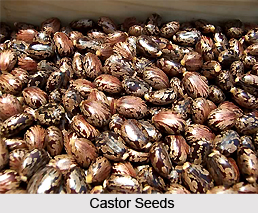 Castor seeds were an important item of trade in ancient Egypt. It has been discovered in tombs, dating back to 4000 B.C. In India too, castor was has been in use since ancient times. In the Susruta Atharvaveda, going back to 2000 B.C., it is mentioned as an aboriginal plant and that its oil was used for lamps. Two varieties-the red and the white seeded-are also referred. The oil was, and is still, used widely in local medicines. The Chinese have been using the oil for medicinal purposes for centuries.
Castor seeds were an important item of trade in ancient Egypt. It has been discovered in tombs, dating back to 4000 B.C. In India too, castor was has been in use since ancient times. In the Susruta Atharvaveda, going back to 2000 B.C., it is mentioned as an aboriginal plant and that its oil was used for lamps. Two varieties-the red and the white seeded-are also referred. The oil was, and is still, used widely in local medicines. The Chinese have been using the oil for medicinal purposes for centuries.
The castor plant seems to have originated in eastern Africa, particularly around Ethiopia. It now grows all through the temperate and tropical regions and prospers under various diverse climatic conditions. It can be grown almost anywhere and this is one of castor`s greatest virtues.
Methods of usage
Castor in any form is utilising, whether for joint pains, or for skin beautifying, or problems related to lactation or birth control.
Healing Power and Medicinal Properties of castor seeds
Castor is used very efficiently in the treatment of rheumatic and skin irritations. It is a non-toxic laxative.
Rheumatism cured by castor seeds
A poultice of castor seeds can be implemented with favourable results to gouty and rheumatic inflammations. A decoction of the roots of the castor plant with carbonate of potash is useful in treating lumbago, rheumatism and sciatica. A paste of the kernel without the embryo, boiled in milk, is also implemented as a medicine in such conditions.
Skin Disorders cured by castor seeds
A poultice of castor leaves is useful as an external coating to boils and inflammations. Encrusted and heated with some tasteless oil such as coconut oil, the hot leaves can be massaged over guinea-worm wounds to pull out the worms. A poultice of castor seeds is also implemented to scrofulous abscesses and boils due to tuberculosis of lymph nodes.
 Problem of Breast Milk Secretion healed by castor seeds
Problem of Breast Milk Secretion healed by castor seeds
Castor oil massaged over the breast after child-birth increases the flow of milk, because it energises the mammary glands. Castor leaves can also be used to foment the breasts, for similar purposes.
Dandruff healed castor seeds
If applied everyday as hair oil, it amplifies hair growth and cures dandruff.
Constipation cured by castor seeds
Castor oil is a plain, non-toxic laxative and can be used without any strict contemplation and restriction of weather and the physiological quality of the patient. In general, spring is the best season to dispense laxatives, but castor oil, can securely be used all through the year. It simply faints after finishing its purgative action, making the patient sense a mild irritation in the anus during that time.
Implementation of castor oil as a laxative is quite uncomplicated. About 30 to 60 grams of pure unscented castor oil is administered orally, with 250 to 375 grams of lukewarm milk. It shows its action in just after an hour.
Those who find its use nauseous and inedible, can have it with ginger water or aqua anisi instead of milk. This hugely cuts down its ugliness, while obliterating mucous and encouraging sound appetite.
Other Uses of castor seeds
Natural Birth-Control -- According to Ayurvedic and Unani dissertations, if a woman chews one castor seed daily at a stretch for seven days after menstruation, she turns infertile. This has been construed by many that castor seed is a herb for birth control and if the woman gulps down one castor seed after the menstrual cycle, she will not conceive during that month. When pregnancy is coveted, the practice can be dispensed with and conception follows after a year.
Castor oil massaged over the body, before bath, keeps the skin in the pink and bestows blissful sleep. Such an oil bath may be taken once a week. Implementing castor oil over hands and feet before going to bed keeps them supple and similarly massaged over the eyebrows and eyelashes keeps them well-groomed.
Precautions - Repeated use of castor oil as a purgative should he debarred, because it causes secondary constipation, i.e., relapse of the condition after cure. People suffering from kidney infections should not have castor oil as a laxative. It should also not be used in times of stomach aches or intestinal infections such as appendicitis, enteritis or swelling of the small intestine and peritonitis. Large dosages of castor oil during the premature months of pregnancy may induce miscarriage.
Composition
The castor is a humble, yearly plant. It reaches a height of 1 to 7 metres. It has well-developed roots, with green and reddish stems which turn concave with age. The fruit is a globular capsule, with tiny grey seeds with brown spots.
The seeds of the plant contain alkoloid ricinine and toxalbumine ricin. They produce a fixed oil, which is used primarily for medicinal purposes. Though castor plant or its oil is not a food, yet it is one of the most ordinarily used oils all over the world as a safe laxative and drug for lessening discomfort of the skin and relieving inflammation and pain.
Castor oil mainly consists of ricinoleate of glycerol or triricinolein, with a small measure of palmitin and stearin. Unlike most fixed oils, castor oil owns the extraordinary property of blending with ethyl alcohol and glacial acetic acid in all proportions. The glycerides of ricinoleic acid in castor oil are mainly responsible for its purgative effect.



















